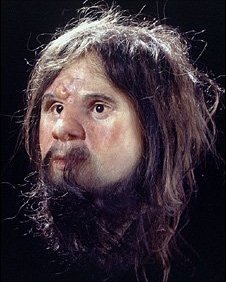Filed under: Europe, History, United Kingdom | Tags: circa 7000 B.C., The Canyon Cave Man, Today's Direct Descendant

…..The Canyon Cave Man. Not long after the last Ice Age, not far from the western sea, a young man was buried in a cave set high in the walls of a limestone canyon. Beside him lay a strange long object made of antler bone, variously described as some sort of secptre or perhaps a spear-straightener. The shallow grave on the cave floor was surrounded by thousands of flints — the non-perishable parts of Stone Age spears, knives, scrapers and burins. These in turn were accompanied by heaps of bones from the birds and animals which had supplied the cave dweller’s diet; hence wild horse, reindeer, and red deer; blue hare, brown bear, Arctic fox, and willow grouse; pig, ptarmigan, peregrine falcon; and one solitary and much older, mammoth bone. The cave and its contents remained undisturbed until rediscovered in modern times.
…..Caves were one of the favorite places of refuge for prehistoric people. They provide shelter in all seasons, an even temperature, and protection from wild animals. Unlike a neighboring cavern, which had once served as a den for hyenas and which had been used by humanoids in far remoter ages, the ‘Canyon Cave’ had not been inhabited before the last ice had melted. Its cool, but never freezing air was ideal for the growth of of stalactites and, in our own times, for the fermentation of cheese. When the Anglo-Saxons arrived some seven or eight thousand years after the cave burial, they founded the nearby village, and called it Ceodor—their word for a canyon or ravine. When the Normans came five hundred years after the Anglo-Saxons, they called the ravine a gorge — their word for a throat and for a narrow valley. …
…..For ninety years after its discovery in 1903 in Gough’s Cave, Cheddar Gorge, the skeleton of ‘Cheddar man’ was kept in London’s Natural History Museum. But in 1996 it was the subject of an extraordinary experiment. It was sent to the Institute of Molecular Medicine in Oxford for DNA testing, and samples of its mitochondrial DNA were compared with a score of similar samples taken from volunteers among the villagers in the present-day Cheddar district. To the astonishment of the scientists, as The Times reported, ‘a close match was found between Cheddar Man and Mr. [Adrian] Targett’, a forty-two-year-old history teacher at the Kings of Wessex Community School in Cheddar Village. The experiment had proved beyond reasonable doubt that a man living in late twentieth century Britain was a direct descendant through the maternal line, of a person living in the same locality in the Middle Stone Age.
This account comes from Norman Davies The Isles: a History. Mr. Davies goes on to explain that the Targett case would indicate that a substantial proportion of people in modern Britain form part of local kinship groups which have had a continuous existence for three or four hundred generations.
Then came the Celts, Romans, Saxons, Vikings, Normans, and Angevins of historic times. The head, above, is a forensic reconstruction from the skull of Cheddar Man, c. 7,000 BC.
I have long found this account absolutely fascinating, and thought you might too. This is what thinking about Richard III got me into.
2 Comments so far
Leave a comment



























another AE gem very cool
LikeLike
Comment by Mike Schirman (@hey_sherm) February 7, 2013 @ 8:34 amThat’s just a story I can’t get out of my head. More ‘wow’ factor I guess.
LikeLike
Comment by The Elephant's Child February 7, 2013 @ 1:19 pm